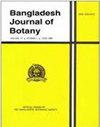商用细菌接种剂对小麦和一年生豆科植物混合青贮饲料发酵和营养质量的影响
IF 0.3
4区 生物学
Q4 PLANT SCIENCES
引用次数: 0
摘要
本研究测定了使用各种商业细菌接种剂(先锋 1188、先锋 11A44 和先锋 11CFT)的小麦和一些冷季型一年生豆科植物(饲用豌豆、禾本科豌豆和薇菜)混合青贮饲料(25:75、50:50 和 75:25)的发酵质量、微生物数量和营养价值。小麦和豆科植物分别播种在不同的地块中,当小麦出苗后 180 天左右达到面团期时收获这些植物。本研究采用因子(3 种豆科植物×3 种接种剂×5 种混合物)排列设计。结果表明,豆科植物种类对 ADF、粗灰分、pH 值、乳酸菌、肠杆菌、酵母菌和霉菌、乳酸、乙酸、丙酸、丁酸和氨氮的影响显著(P < 0.05)。粗蛋白、青贮发酵特征和微生物种群受接种剂的影响(P<0.05)。混合比例对青贮干物质、化学成分、相对饲料价值和发酵参数的影响显著(P < 0.05)。结果表明,使用接种剂 1188 作为添加剂,将 50%的小麦和 50%的禾本科豌豆混合制成青贮饲料,在营养价值和发酵质量方面都能取得良好的效果。孟加拉国植物学杂志52(3):775-782,2023 年(9 月)本文章由计算机程序翻译,如有差异,请以英文原文为准。
Effects of commercial bacterial inoculants on fermentation and nutritive quality of wheat and annual legume mixed silages
In the present study fermentation quality, microbial populations and nutritive value of wheat and some cool season annual legume (forage pea, grass pea and vetch) mixed silages (25:75, 50:50 and 75:25) using various commercial bacterial inoculants (Pioneer 1188, Pioneer 11A44 and Pioneer 11CFT) were determined. Wheat and legume species were sown in separate plots and these plants were harvested when wheat reached the dough stage about 180 days after plant emergence. The present study was conducted in a factorial (3 legume species×3 inoculants×5 mixtures) arrangement design. Results showed that effects of legume species on ADF, crude ash, pH, lactic acid bacteria, enterobacteria, yeast and mold, lactic acid, acetic acid, propionic acid, butyric acid and ammonia nitrogen were significant (P < 0.05). Crude protein, silage fermentation features and microbial populations were affected (P<0.05) by inoculants. Effects of mixture ratios on dry matter, chemical compositions, relative feed value, fermentation parameters of silages were significant (P < 0.05). It was determined that ensiling the 50 % wheat with 50% grass pea with the use of inoculant 1188 as an additive could give a good result both in terms of nutritive value and fermentation quality. Bangladesh J. Bot. 52(3): 775-782, 2023 (September)
求助全文
通过发布文献求助,成功后即可免费获取论文全文。
去求助
来源期刊

Bangladesh Journal of Botany
生物-植物科学
CiteScore
0.80
自引率
0.00%
发文量
77
审稿时长
9 months
期刊介绍:
Bangladesh in situated on the north of Bay of Bengal. Climatically it is a humid subtropical country. Most of the land is deltaic plain of two great rivers, the Ganges and the Bhrammaputra and it tributaries. The country has rich diversity of plants. Main crops cultivated are Rice, Jute, Wheat, Maize, Sugarcane, Mustard and different kinds of Lentils. There are a good number of Public and Private Universities and Plant Research Establishments.
Bangladesh Journal of Botany is the official organ of the Bangladesh Botanical Society established in 1972. Since 1972 Bangladesh Journal of Botany is being published regularly. Two issues of the Journal are published, one in June and another in December.
Scientific papers (Full paper and short communication) on any field of Plant Sciences from anywhere in the World are considered for publication in Bangladesh Journal of Botany.
 求助内容:
求助内容: 应助结果提醒方式:
应助结果提醒方式:


